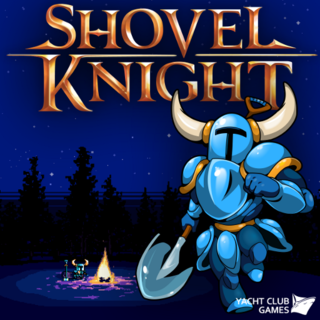INTRO:
King Knight was a goofy character in the saga of Shovel Knight. He is frequently mocked by the other player characters for not being a real king, but tries to do so anyway by surrounding himself with the trappings of a monarch. He is also implied to be quite driven and mad, which make for a character that is more interesting than most of the other antagonist Knights.
Thus, King of Cards is an expansion that focuses on this character, specifically his descent from a foppish but skilled adventurer to a maniacal despot. There is also the introduction of a card- and tile-based game, though this would not be unanimously welcome.
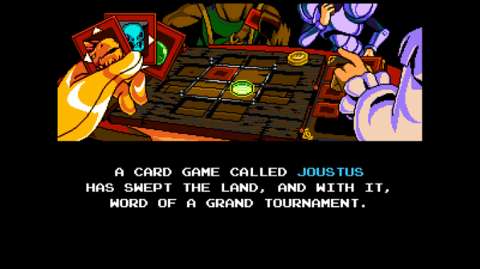
PREMISE:
The King Knight was an adventurer, much like any other. However, he aspires to be more; specifically, he wants to be a ruler with subjects that cater to his whims. He is not high-born, however, and his only willing subjects are his pet rats. (By the way, King Knight’s levels in the previous story campaigns have a lot of the propeller-using rats.)
Most do not take his aspirations seriously, and there are more than a few who can see the egomaniac for whom he is. The only other sapient person that loves him unconditionally is his own mother, who refers to him as a “prince”, much to his chagrin.
One day, he hears of “Joustus”, a card-based game that has become popular. There is a tournament too, in which the winner would be crowned the “King of Cards”. Determined to become King of something, he sets out to win this tournament.
Unfortunately, the complexities of (fantastical) reality would catch up to him (or rather, he fails to catch up to them). This finally pushes King Knight off the deep end and into service to the Enchantress.
PREQUEL CHARACTERS:
The story of this campaign appears to happen shortly after the Enchantress has taken control of Shield Knight and recruited the Spectre Knight. Many characters that were introduced in previous story campaigns are here too, with notable exceptions such as Shovel Knight himself. The later stages in King of Cards also imply that its story overlaps a bit with the early parts of Spectre of Torment.
Many of them express themselves in ways that are very different from those seen in the chronologically-later campaigns. This is perhaps to be expected, because the Enchantress has yet to establish her presence in the valley and the Pridemoor kingdom has yet to be usurped.
For example, there is Cooper, previously only known as the “Airship Enthusiast”. He is given a substantial role in this campaign, being the owner and captain of the airship that is King Knight’s mobile base. He is also revealed to be quite familiar with Propeller Knight, who is established as a pirate lord in this story, prior to pledging his service to the Enchantress.
KING KNIGHT AS A PLAYER CHARACTER:
King Knight has yet to gain the trappings and accoutrements of being a grandiose despot in the previous story campaigns. However, he already has his “armour” (which may or may not be actual armour) and his sceptre, as well as being rather nimble and strong. Indeed, it is implied that his vocation, prior to the events of King of Cards, is as a treasure-hunting adventurer.
Like the other titled Knights, he can jump with gusto and is capable of combat. He will be going about collecting treasure, avoiding hazards and defeating the other Knights.
These are just about all of the similarities that he shares with the others though – or even himself as a boss character.
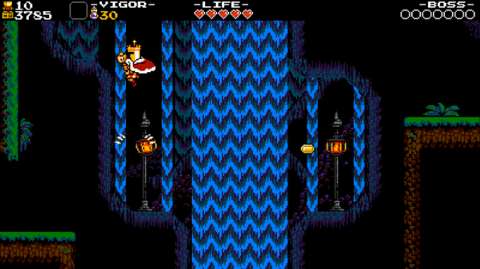
FRAILTY:
The first noticeable difference, and perhaps the most amusing one, is that King Knight is a frail player character, despite his appearances.
His health meter has pips that look like hearts, which is not something new in video games. What is notable though is that the meter does not have half-pip notations, i.e. any hit that he takes removes one entire pip at the least. This makes him even weaker than Plague Knight when the latter started his story campaign.
Perhaps this was a response to criticisms about combat being rather easy. Perhaps this is to point out that his armor is really just for show. Whatever the reason is, the player will have to be careful about the damage that he takes, more so than for the player characters in the previous campaigns.
SHOULDER BASH:
The other player characters attack enemies with their favoured weapons. One would think that King Knight would hit things with his sceptre, just like he does as a boss character, but he does not. In fact, as a playable character, his style of combat is completely different from what has been seen earlier.
Firstly, there is the shoulder bash. He charges forward to hit enemies with his body, shoulder first. Considering that physical contact damage is still something in the gameplay, that his default attack circumvents this rule can seem odd.
ROLLING:
If he does not hit anything during the last few legs of his shoulder charge, the player can have King Knight do a combat roll instead. Somehow, this also damages enemies when his sprite comes into contact with them. If he rolls into rocks, he destroys them and rolls past them. If he rolls into enemies but does not manage to kill them, he bounces off them; if he kills them, he rolls past them.
Rolling is most useful during the boss fights where there are no instant-death hazards. Outside of these situations, rolling is only occasionally needed.
However, not all enemies can be rolled into. For the new player, it is not always clear which enemies these are. Still, there are a few visual signs: for example, Goldarmors who are holding up their shields cannot be rolled into. Another example is the Blitzsteed; rolling into the lance of an oncoming Blitzsteed is definitely not a good idea.
CANCELLING CHARGE AND ROLL:
At any time during a charge or roll, the player can make a control input to move in the other direction in order to cancel the charge or roll. This can happen even in mid-air. However, the King Knight is not likely to be able to do another charge or roll immediately afterwards.
SPIN-JUMP:
King Knight’s third combat move is a spin-jump. For better or worse, he will automatically do this if his shoulder charge hits something; this is the only way to have him do a spin-jump.
During his spin-jump animation, the player can control him like the player could with Shovel Knight’s Shovel Drop attack. He will rebound off enemies and other things that can be damaged with the spin-jump, thus allowing for more hits if the player can redirect his descent. (If this looks familiar, this is because it is based on the spin-jump of the Super Mario Bros games.)
If he has just rebound off something, the player can have him perform another shoulder charge, even in mid-air. This is used for some challenging and optional platforming sequences, many of which require the player to chain rebounds and charges alternatingly.
However, there is no indication whether the player can have King Knight perform a shoulder charge while spin-jumping or not. The sprites for King Knight for either case are the same.
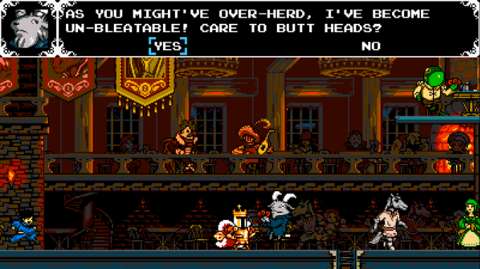
SKATING:
There are some levels with slipping hazards; these have been seen before in previous story campaigns. The other player characters are barely capable of dealing with the slippery ice.
However, for whatever reason, King Knight is a natural ice skater. Although he cannot stop in place, he can control his direction quite well and all of his jumps off the ice are spin-jumps, which he can also shoulder-charge out of.
HITTING HEARTS OUT OF ENEMIES:
It has been mentioned earlier that the player character is rather frail. However, there is a system in place to reward skilled players who minimize risks while maximizing damage output instead of going for rush-down tactics.
When King Knight has inflicted at least three pips of damage on an enemy (as can be observed during boss fights), a heart pops out of the enemy. This heart drifts downwards, waiting for the player character to come into contact with it. Each heart restores one pip.
The heart can drop into pits, making it hazardous to retrieve. Enemies can clip through the heart too. The heart, like any other loot drop, will also eventually disappear. Considering that each heart only gives one pip, the player will have to be careful about when to go after the heart.
Since cumulative damage of 3 pips have to be inflicted on the same target and the target has to be alive when that damage is achieved, weak enemies never yield hearts. Therefore, the player would have to be efficient in eliminating lesser mooks.
VIGOR:
In terms of gameplay, King Knight uses the same magic counter as Shovel Knight. Vigor has to be regained by drinking potions that are dropped by defeated enemies. (These look prettier than the ones that Shovel Knight drink, by the way.)
HEIRLOOMS:
Heirlooms are King Knight’s counterparts for the magical items that the other player characters use. As befitting their name, Heirlooms are obtained from characters that have inherited things of value from their ancestors. (King Knight of course has no heirlooms of his own because he does not have a grand lineage in the first place.)
That said, these characters no longer need their heirlooms. Some of them happen to be the last of their line and are quite dead, so their tangible belongings are of no use to them. Some are just down on their luck and need some funds. That said, the characters want Merit Medals in return (though how exactly these benefit them is unclear).
As to be expected of magical items in Shovel Knight, the heirlooms grant complementary powers. For example, the Dueling Gloves essentially give King Knight a standing attack, much like the Plague Knight’s Staff of Striking.
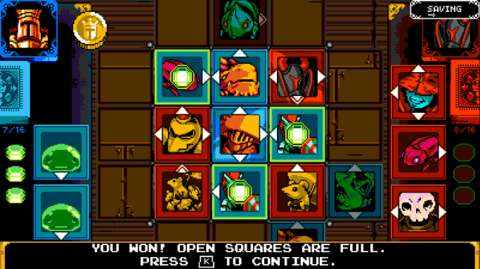
DECREES:
Decrees are consumable items, similar to the filled chalices that Shovel Knight use. In the first half of the playthrough, these are rare items that are only found in the caches that appear in the world maps. The player will have to be sparing in their use.
Interestingly, each piece of decree takes up one slot in King Knight’s inventory. Where the other player characters’ inventory slots do not mean a thing because they are already reserved for specific items, the player can fill King Knight’s inventory with decrees as long as there is space. Therefore, the player can compensate for King Knight’s relative lack of versatility early in the playthrough by filling the slots with decrees.
Eventually, King Knight comes across the Troupple King. In this story campaign, the Troupple King does not appear to have the policy of granting his boons to those who have chalices. Instead, he sells the magical decrees. As to be expected, these do not come cheap.
However, by the time he appears, the player would be accumulating quite a lot of money. Spending some on the decrees would not lead to many opportunity costs, especially if the player has already maxed out King Knight’s health.
As for what the decrees do, they summon small flying creatures. They stay around for about a minute, after which they disappear. They vary in actual value during gameplay.
The least useful of them is the baby Griffoth, who fires projectiles at enemies. The projectiles are not particularly powerful and can be blocked by obstacles. Furthermore, they are not reliable at hitting moving targets.
The second is a servile Birder, which King Knight can stand on so that he and the creature can bounce around the screen. The player has some degree of control over the Birder’s movement, but it can only ever move in diagonal directions. Moreover, King Knight can be knocked off the Birder, so this is only ever useful if there are no enemies around – which is a rarity. Having the Birder disappear while they are both over a fall hazard is not a great outcome either.
The most useful is the Troupple servant. The Troupple servant restores the player character’s health by one pip over every three seconds. This is useful during boss fights, if the player is confident about getting King Knight out of harm’s way.
SMALLER LEVELS:
One of the (perhaps minor) criticisms levelled at the previous story campaigns was that some of the levels can be rather long, e.g. having many checkpoints. Some can be completed in under an hour by a reasonably skilled player, but other people would have to resort to brute determination and spending more time to get past certain sections. This would not have been a problem if there is some means of saving progress through a level, but there is not any.
The levels in King of Cards partially address this complaint by breaking down the levels seen in the other story campaigns into smaller ones. The effect of this can be seen in the world map too; there are more nodes in the grid that represents the places where King Knight can travel to compared to the grids in the campaign for the Shovel and Plague Knights.
Many of these small levels are not ended with boss fights either. Instead, there is a slightly different gameplay mechanism for completing levels.
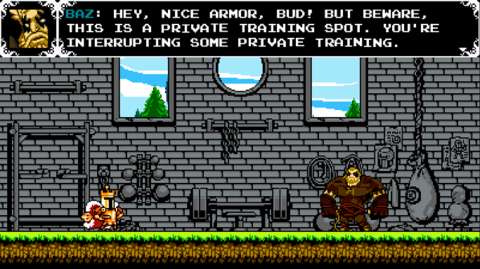
RAT ROPES:
In the other story campaigns, levels that do not end with boss fights would end with an arrow signage showing the exit of the level. This is serviceable, but quite dull because the player character is merely walking off the screen.
These signs are there in a few levels, but for most levels, King Knight has a grandiose but risky way of exiting them, for better or worse. This is the “Rat Rope”, called so because these are operated by the King Knight’s (rather well-trained) rat servants.
There are two types of Rat Ropes, and both types will hover in the air, thus requiring the player character to do some platforming to get to them.
LEVEL EXIT RAT ROPES:
The regular type of Rat Ropes is large and unmistakable. However, these Rat Ropes are often lingering above instant-death pits, or require considerable platforming to reach. This can be occasionally frustrating, especially if the player already has had enough of a level.
ALTERNATIVE LEVEL EXITS:
Some levels have alternative exits. This can be seen in the visuals for their nodes on the world map. These nodes have links of two colours: red and green. The red link indicates the route that can be opened if the player completes the level using the alternative exit.
The route to the alternative exit is typically implemented as a hidden or partially hidden path within the level. These may lead to a large red Rat Rope, which is the alternative level exit. Otherwise, the route leads to a small red rope that leads to another section of the level, which is then bookended with a large red Rat Rope. Both involve challenging platforming.
The alternative route is mutually exclusive to the route that leads to the regular exit, so if the player wants to unlock the other link, the player has to replay the level again.
The alternative links lead to optional levels. Some of these levels give special one-time-only rewards. These levels also provide some exposition on existing characters, such as King Pridemoor’s advisor, as well as introduction to new characters such as Traitorus.
PLATFORMING CHALLENGE RAT ROPES:
Some levels have hidden paths that lead to a screen that has small rat ropes in them. These indicate the presence of optional platforming challenges.
These ropes function a lot like the chemical cannons that Plague Knight uses to launch himself and return to the mandatory sections of a level. However, the difference here is that there are a pair of these smaller rat ropes: one is for entry into the platforming challenge area, and one is for the exit. Both require deft platforming on the part of the player, because they are always situated over precarious places.
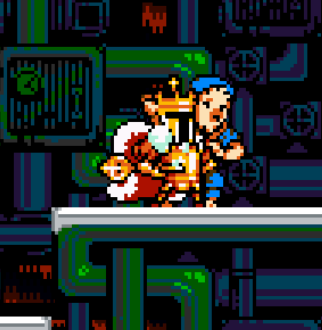
NEW AND REUSED LEVEL HAZARDS:
Most of the hazards and platforming features that have been seen in Spectre of Torment are in this expansion too. These include the lanterns, which King Knight can shoulder-bash and spin-jump from.
The smooth surfaces in Spectre of Torment are also in this game. These prevent King Knight from spin-jumping off them after hitting them with a shoulder charge.
The new ones are unique to certain levels. The most notable examples of these are the platforming features in the levels that are associated with King Troupple, who is a boss in this game, by the way. His levels feature platforming objects that resemble the flora and fauna at ponds and bogs.
For example, there are floating lotus flowers that the player character can use like spring boards. As usual, the platforming features and hazards are introduced in the first screens of the levels, in which the player can experiment with the features.
MERIT MEDALS:
The collectibles in King of Cards are “Merit Medals”. Like the others in the other story campaigns, these float about, waiting for the player character to collect them. Typically, they are found at hidden paths, or at platforms that are not straightforward to reach.
Indeed, these collectibles seem a tad more difficult to get than the ones in the other story campaigns. This is mainly because many of their platforming challenges require King Knight to shoulder bash an enemy and then use the subsequent spin-jump to hit the same enemy again or another enemy to reach the platform with the medal.
The collected Merit Medals can be exchanged for Heirlooms or upgrades to King Knight’s Vigor meter. There is an NPC that also tracks the number of Merit Medals that have been collected and rewards the player character for reaching certain milestones. (Oddly enough, this NPC is none other than the Bard from Shovel of Hope.)
NEW ENEMIES:
King of Cards introduces enemies that have not been seen before in the previous story campaigns.
Firstly, there is the cluster of rats that are somehow flying about using a single propeller. Unlike the usual flying rats, this can take a lot of hits, amusingly shedding rats along the way. The cluster is more difficult to utilize as a platforming tool than individual rats, due to the cluster’s hit reaction.
Next, there are the Troupple King’s servants, which have thus far been represented as allies. In King of Cards, they defend the Troupple King’s demesne against King Knight’s intrusion.
They are unending, constantly respawning to hassle the player character with their gusty leaps. They are as much enemies as they are platforming hazards – something that the developers are well aware of because they often imperil any attempts at getting treasure in precarious nooks and crannies in the Troupple King’s levels.
Then there are the Sumo Goldarmors and their variants. These are tougher and trickier than the usual Goldarmors, and perhaps are best evaded than fought. These are only ever found in King of Cards, suggesting that these did not survive the Goldarmors’ transition into the service of the Enchantress.
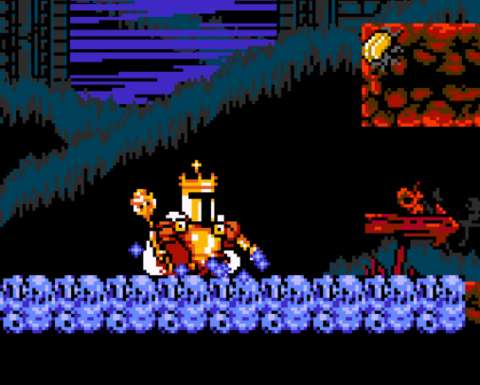
THE AIRSHIP:
King Knight’s mobile base has been mentioned a few times already. This is the airship of Cooper, the Airship Enthusiast. Having ‘pledged’ his service to King Knight (for reasons that are not revealed until later), Cooper has his airship at the King Knight’s literal beck and call. At any moment in the world map screen, the player can have King Knight summon the airship so that he can return to it.
The Airship becomes host to the allied NPCs that King Knight meets and impresses along the way. Indeed, contrary to the impression that he makes in the other story campaigns, King Knight would be impressing so many people that the Airship would be having a lot of guests and crewmembers aboard. Gameplay-wise, these characters function as service providers, in addition to sources of lore prior to the reign of the Enchantress.
For example, there is King Pridemoor, who did not get much of any time as a character in the other story campaigns, other than complaining that he has been deposed in Shovel of Hope (and hiding in the basement) of an inn. In this story campaign, his backstory has been retconned: not only is he a much-respected ruler, he is also former adventurer and a skilled blacksmith and engineer. He even has a mechanised suit of armor. (He also does not rhyme like he did in Shovel of Hope.)
Gameplay-wise, he acts as a major boss. After being defeated, he joins the airship as an NPC that provides alternate armor sets for King Knight.
JOUSTUS – OVERVIEW:
The highlight of the gameplay is perhaps not the differences between King Knight and the other player characters, for such a kind of highlight has been done before twice already prior to King of Cards. Rather, the highlight is the card-based game of Joustus – for better or worse.
Perhaps Yacht Club Games is earnest in doing something very different. Perhaps it is trying to have its own slice of the card-game fad that was trending prior to King of Cards. Whatever the reason, Joustus is markedly different in theme, pacing and perhaps even appeal from the rest of the gameplay. After all, it is unlikely that every player who follows 2D platformers would appreciate having a card-based game in their game.
That said, Joustus mixes the gameplay elements of a hand of cards with a grid of tiles. There are two players, who are both trying to claim ownership of specific tiles. Ownership of the tiles decide the winner.
THE GRID:
The grid is composed of square tiles. There are generally two types of tiles: the first is raised, whereas the other is sunken (called “Graveyard” tiles in-game). Raised tiles can receive cards directly from the players’ hands and cards that have been pushed onto them, whereas the Graveyard tiles can only receive cards that have been pushed onto them.
These distinctions are important to keep in mind, especially considering that there are always more cards than there are tiles. There will be more elaboration on types of tiles later.
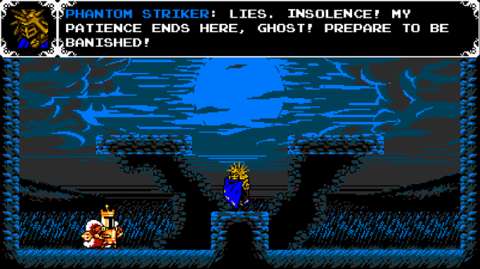
PLACING AND PUSHING CARDS:
A card can be placed onto an empty regular tile directly, in which case nothing happens. However, a card can be placed onto a tile that already has a card in order to push the latter away. Pushing cards is a major part of the gameplay of Joustus.
The direction of pushing depends on the orientation of the card to be placed with respect to the tile with an existing card; the player can pick the orientation. Next, the arrows on the cards are considered. If the permutation of arrows allows the pushing, the pushing will occur according to the visual display that is shown to the player prior to placing the card. Most of any further effects are shown to the player in the preview too.
ARROWS ON CARDS:
As for the arrows on the cards, these indicate the directions of the pushes that they can make. The types of the arrows are also important.
A single chevron is the icon for a regular arrow. Pushes with regular arrows can only be performed against cards that do not have arrows in the opposing direction.
An arrow with double chevrons can make pushes that overcome regular arrows of opposite directions on cards that would be pushed.
There are also bomb arrows. These work like regular arrows, but if the card with bomb arrows are pushed onto another card, it blows up the latter. This can be used to remove opponent-held cards, or work around restrictions due to rows or columns of cards (more on these later).
Late into the playthrough, cards with triple-strength arrows appear. These can push even double-chevron cards around, but they lose their arrows within a few turns.
More arrows is not always better; the same goes for arrows that are more potent than regular arrows. The reason for this is the aforementioned restrictions on pushes with arrows against cards that have arrows in the opposite direction. These restrictions apply on pushes against the player’s own cards too. Therefore, a poor placement with a card that has many and/or powerful arrows can stymie the player’s options later in the next turn.
ROWS OR COLUMNS OF CARDS:
If a card is going to be pushed, the card ahead of this card will have to be considered too. If this next card has arrows that go against the arrows of the card that is doing the pushing, then the abovementioned restrictions will apply. For example, if a card with regular arrows is going to push a line of cards, all of the cards in that line must not have arrows that point in the opposite direction.
These restrictions are used to stymie further moves as the grid gets filled with tiles. Indeed, it is possible that a match can end because there are no more valid moves.
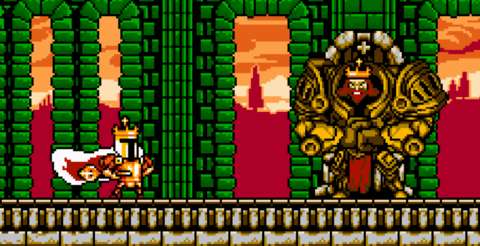
GEMS:
Some of the tiles have gems on them. The number of tiles for a specific match is always certain, but the locations of the gems are not. They are randomly placed on the tiles before the start of the match, but otherwise they stay where they are.
The objective of either player is to place their cards onto the tiles with gems. The player whose card is under a gem is considered as having controlled the gem. Control can be lost if the card under the gem is pushed away or otherwise destroyed. Therefore, control of the gems is not a certainty unless the card on it cannot be removed or shifted in any way. In certain matches, there are opponents that can just outright move the gems too.
OPPONENTS WITH POWERS:
Some opponents have the privilege of having powers that give them an advantage or outright stymie the player. These are the “champions” of Joustus, who likely get their titles by practically cheating.
For example, the Black Knight outright destroys a row of cards. For another example, Horace the living (but unmoving) suit of armor can cause the player to forfeit a turn if the player takes too long.
These are optional challenges. If the player pursues them to the end, the player gets an optional boss fight that can be quite challenging (and frustrating, because Heirlooms are disabled in this fight).
END OF MATCH:
Joustus is that kind of game where the players’ performances are only tallied after the conditions to end the match has been achieved. The conditions are that there are no more raised tiles that can be filled with cards, or no cards in either player’s deck can be placed on the tiles.
When this happens, the number of gems in either player’s control is tallied. The player that controls more gems is the winner.
CLAIMING OR LOSING CARDS:
The winner removes all of his/her/its cards from the grid; the loser’s are retained. The winner then gets to pick any of the loser’s cards to claim it.
In the case of CPU-controlled opponents, having cards claimed from them does not permanently remove the card from their deck; this does not happen at all. They are presumed to have found a replacement.
The player’s deck is reduced if defeat occurs, however, but only if the player accepts the defeat. The player cannot avoid this in-game, but less scrupulous players would just go for a game reset before the playthrough’s auto-save updates itself.
That said, a victorious opponent that claims the player’s card does not get to keep that card; the opponent will never field that card.
GEM SWEEP:
In the case of the winner having claimed all gems on the grid, the winner gets to claim more than one card. This does not always happen of course, mainly due to luck being a major factor in the gameplay of Joustus.
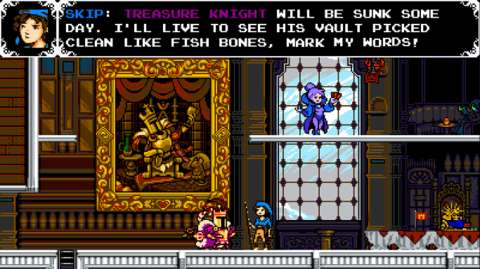
BUILDING A DECK:
Any Joustus player can only have 16 cards in their prepared deck. In the case of CPU-controlled players, their decks are fixed. The player gets to alter King Knight’s deck, and it is in the player’s interest to do so.
As to be expected of deck-building, the player will want to have a balanced mix of cards so as to have something to play for any possible situation. There are, however, cards that are practically straight upgrades over the default ones.
DEFAULT CARDS:
There are four cards that are available to the player from the get-go. Each of these cards has a regular arrow in one of the four cardinal directions. It is possible to win with these cards, but only if luck makes this possible.
The player has an unlimited supply of these cards. Therefore, the player will still have some cards to use if the player has been losing badly (assuming that the player accepts the losses at all).
CARDS WITH SPECIAL PROPERTIES:
Some cards have more than just arrows to define themselves with. They have icons on their bottom left corner, which represent the special properties that they have. These properties make them more complex to use than cards that to do not have them.
For example, some of the later cards can flip the ownership of the cards that they push (including cards in entire rows or columns, if these are pushed). These cards can be potent when they are available and used at the right time.
Cards with special properties cease to exhibit their properties if they are pushed into Graveyard tiles. The only exceptions are cards that have the special property that lets them be played on Graveyard tiles in the first place.
GRAVEYARD TILES:
Speaking of which, almost all grids have Graveyard tiles; these are the aforementioned sunken tiles. These prevent the placement of most cards on them. They can receive any cards that are pushed onto them, however; these cards have their special properties disabled.
There are cards that can be played on Graveyard tiles. When placed, these cards convert the titles that they are on to regular tiles, but only these tiles. Other cards can be used to push them around, but the tiles that these cards take will revert to Graveyard tiles if they were these in the first place.
The player will want to monitor how many Graveyard tiles have yet to be filled. Once they are filled, pushing columns and rows of cards become more difficult.
HAZARDS & OBSTACLES ON THE GRID:
From the second segment of the world map onwards, the Joustus grids have hazards and obstacles that complicate the placement of cards.
The first of these obstacles are rocks that are encasing certain tiles. These prevent any cards from being placed or pushed into them. At the same time that they first appear, the player is also introduced to the cards with bomb arrows, which are one of few ways to get rid of the rocks.
Next, there are tiles with trapdoors. These will eliminate the first card that is placed on them, but they work like regular tiles afterwards.
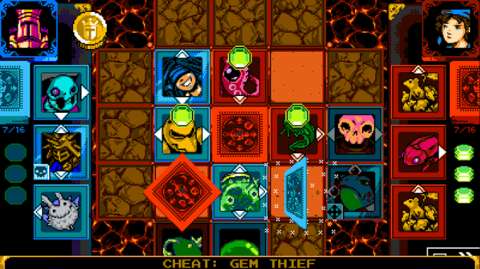
HAND OF CARDS & LUCK OF THE DRAW:
Having cards “available and used at the right time” is not as easy as saying it. This is because, for better or worse, the game uses the system of deck-drawn hands and randomly-shuffled decks, just like most other card-based games.
Either player can have up to 16 cards in the deck, but can only draw and field 3 at a time; this is his/her/its hand. These cards appear to be randomly drawn from the deck; there are no means of choosing which card to draw, including when the deck becomes smaller. Therefore, there is always the risk of none of the cards being usable for the current condition of the grid. Indeed, a player that faces this problem forfeits his/her/its turn.
Thus, the luck of the draw will always be a fickle factor, no matter how much the player tries to optimize his/her deck for any opponent.
DECISION-MAKING OF CPU-OPPONENTS:
Turn-based gameplay with no actual concerns of physical space can give rise to CPU-controlled opponents that are particularly observant and careful with what they have. Incidentally, this is the case for most of the opponents that the player would face in Joustus.
The first few are careless fools who are mainly there to ease the player into the gameplay of Joustus. They frequently make mistakes, even if they could use their next move to stymie the player.
However, after the first section of the world map, the opponents are much better in considering their next move. Thanks to the scripts that they have, they are able to make efficient moves with the cards that they have on hand.
Of course, a cunning and meticulous player can counter them quite readily. However, it is not likely that every follower of Shovel Knight is such a player. Indeed, this is unlikely to be the case for most players: followers of 2D platformers and followers of card-based games are not likely to overlap.
Fortunately, beating Joustus opponents is an optional endeavour. Due to King Knight’s rudeness and rashness, the encounters with the main players of Joustus would do actual battle with him instead of playing Joustus. Therefore, the player does not really need to play Joustus in order to progress in the story.
However, each defeated opponent yields a Merit Medal, which the player would very much want, if only to unlock more gear and upgrades for the King Knight.
CHEAT CARDS:
For whatever reason, King Knight is allowed to cheat through the use of Cheat cards. They are specifically there to deal with the luck of the draw, and one of them would be particularly useful to any player that does not want to deal with the randomized draws.
These cards are always available, but have to be purchased again after they are used. This limitation is there to discourage the player from using them too much, but it is likely that a player who wants more certainty in Joustus would be spending money just to have these.
There are three types of cheat cards. One of them converts the opponent’s hand into the default cards, which is helpful if the player knows that the opponent has a tricky deck. Another lets the player play all three cards in the player’s hand, which can be helpful in gaining as much control of the grid as possible.
The third and perhaps most useful flips the ownership of the cards that have gems. Since the decision-making scripts of the CPU-controlled players are quite capable at capturing gems wherever they could, the unscrupulous player could have them do most of the work at capturing the gems. Using the card at the second last or last possible turn usually leads to a cheesy victory.
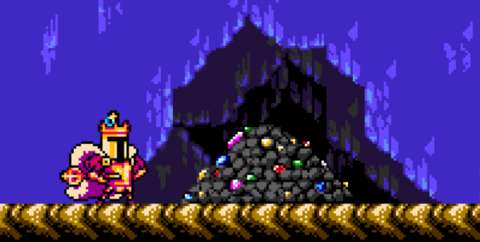
VISUAL DESIGNS:
Many of the visual assets in King of Cards are new. This is perhaps to be expected, because this is before the rule of the Enchantress debuted. The world map shows a lot of places in the valley that have yet to be dominated by the demesnes of the titled Knights. For example, the Lich Yard is just a collection of villages populated by both the living and undead; the Spectre Knight’s macabre mausoleums have yet to be raised.
There are also wholly new visual assets for locales that were not seen extensively in the previous story campaigns. Chief of these are those for the bogs that the Troupple King and its servants live in, and the frozen mountains at the height of the valley.
Characters sport a lot of animation frames in this story expansion, mainly due to the implementation of Joustus. Watching them hold cards – even when they should not be able to – is amusing. Many of the bosses that appeared in the previous story campaigns also sport new abilities, as well as the animations for them. (They also play Joustus.)
For example, Baz, the hulking try-hard adventurer, has a hilarious airborne rolling attack that has him somersaulting and bouncing around the screen. He inadvertently destroys his otherwise well-improvised training area (which were seen in Shovel of Hope and Plague of Shadows in his boss fights).
The proverbial star of the show is of course King Knight. He sports a lot more animations than he did as a boss character, especially those for the use of the Heirlooms that he come across. (It is also worth noting that he has never shown these animations as a boss character, even though he should have retained these heirlooms.)
There are, of course, the visual designs for Joustus. Most of these are just sliding squares with pictures on them, but there are cool effects such as the cards being turned over as their ownership is flipped.
SOUND DESIGNS:
Like the previous story campaigns, some of the music tracks in Shovel of Hope have been remixed to fit King Knight’s theme. The track for Castle Pridemoor is particularly notable as an example of a remix; there are deeper tones in that one, which is perhaps Jake Kaufmann’s way of expressing that the grandeur of the palace prior to King Knight’s usurpation was more authentic.
The different locales also have their own sound effects. The ones at the Troupple King’s domain are particular examples. There are a lot more noises that are associated with water and bubbles in those levels.
The most notable sound designs though are the tracks that Jake Kaufmann has composed for the Joustus matches. They are quite catchy, though listening to them while playing a potentially frustrating luck-dependent game may not be the most ideal way to appreciate them.
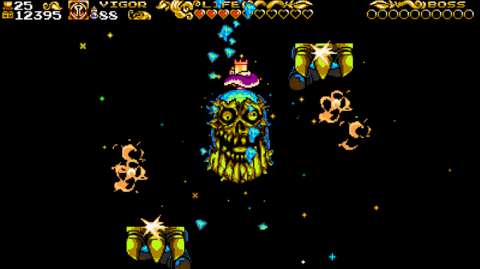
SUMMARY:
At first glance, many of the gameplay designs in King of Cards do not follow the formulae that has been used for the other story campaigns. The player character damages enemies by coming into contact with them with a body part instead of a weapon. There is a substantial mini-game on the side that takes up half of the gameplay experience.
Of course, true to Yacht Club’s promise, the story campaign for King Knight plays very differently from the others. In fact, the differences are so considerable that the setting can seem completely different. The pervasiveness of Joustus as a pastime makes every character seem goofier. Knight Knight doesn’t even fight like he does as a boss character, and he is much better regarded in this story – at least before he makes some terrible decisions.
The differences might be much appreciated by followers of the series who had been expecting more of the same. On the other hand, those who had been wanting more of what they like – namely the platforming gameplay and combat – would not be happy with the inclusion of Joustus, especially if they have had bad experiences with card games.
